Abstract
Cryptococcus neoformans, an opportunistic fungal pathogen, often causes serious and life-threatening infections in immunocompromised hosts as well as in normal individuals. In the present study, purified cryptococcal capsular polysaccharide antigen was examined for its effect on several parameters of immune response and its ability to induce immune response to itself. Injection of the antigen into mice resulted in a dose-related specific antibody response which was detected at the individual antibody plaque-forming-cell level by a hemolytic assay in gel. Relatively low doses of cryptococci induced a maximal response, whereas higher doses resulted in a markedly depressed response. The antibody response to the cryptococcal capsular polysaccharide antigen appeared to be T cell independent and regulated by suppressor T cells, since mice injected with antilymphocyte serum or antithymocyte serum showed specific antibody responses to the antigen that were higher than those of untreated mice. It also markedly affected the in vitro mixed-lymphocyte reaction when added to cultures of mouse spleen cells being challenged in vitro with mitomycin C-treated allogeneic cells. The lower doses stimulated the response, whereas higher doses suppressed it. The macrophage response to yeast cells but not opsonized sheep erythrocytes was also modulated by the cryptococcal antigen.
Full text
PDF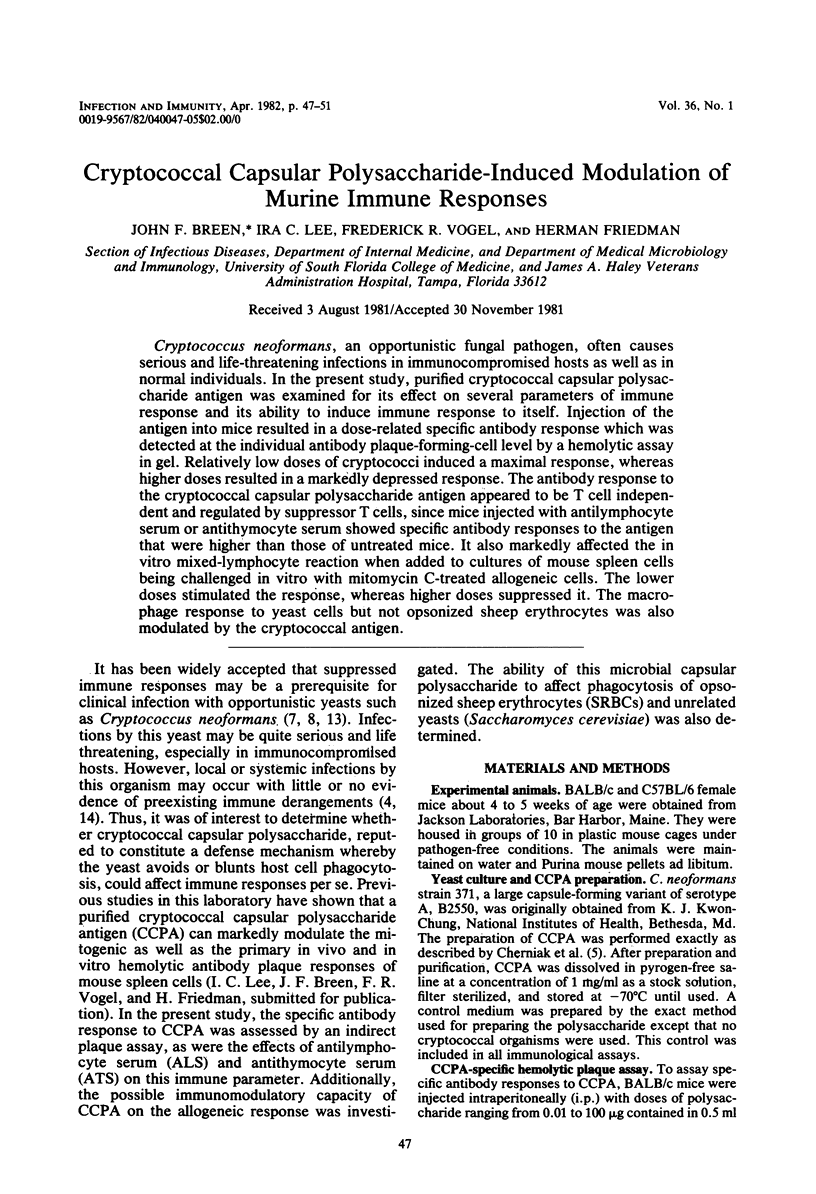
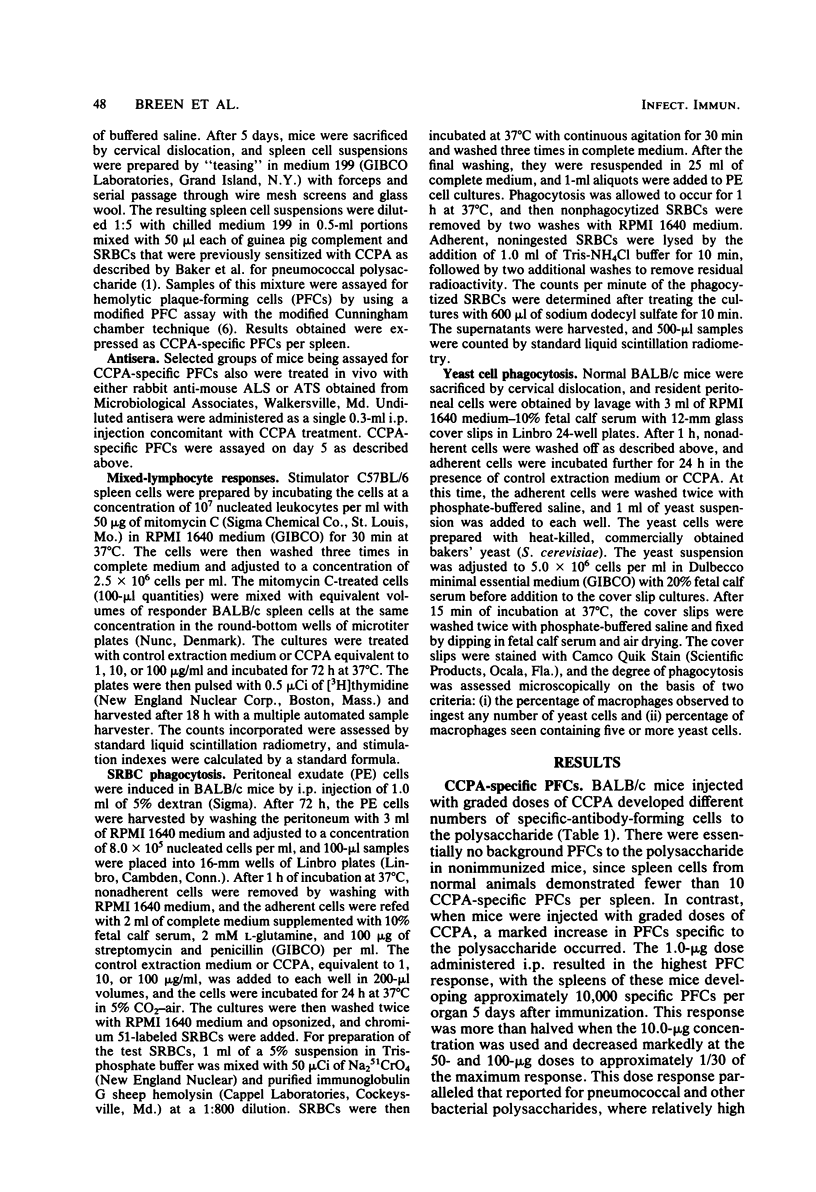
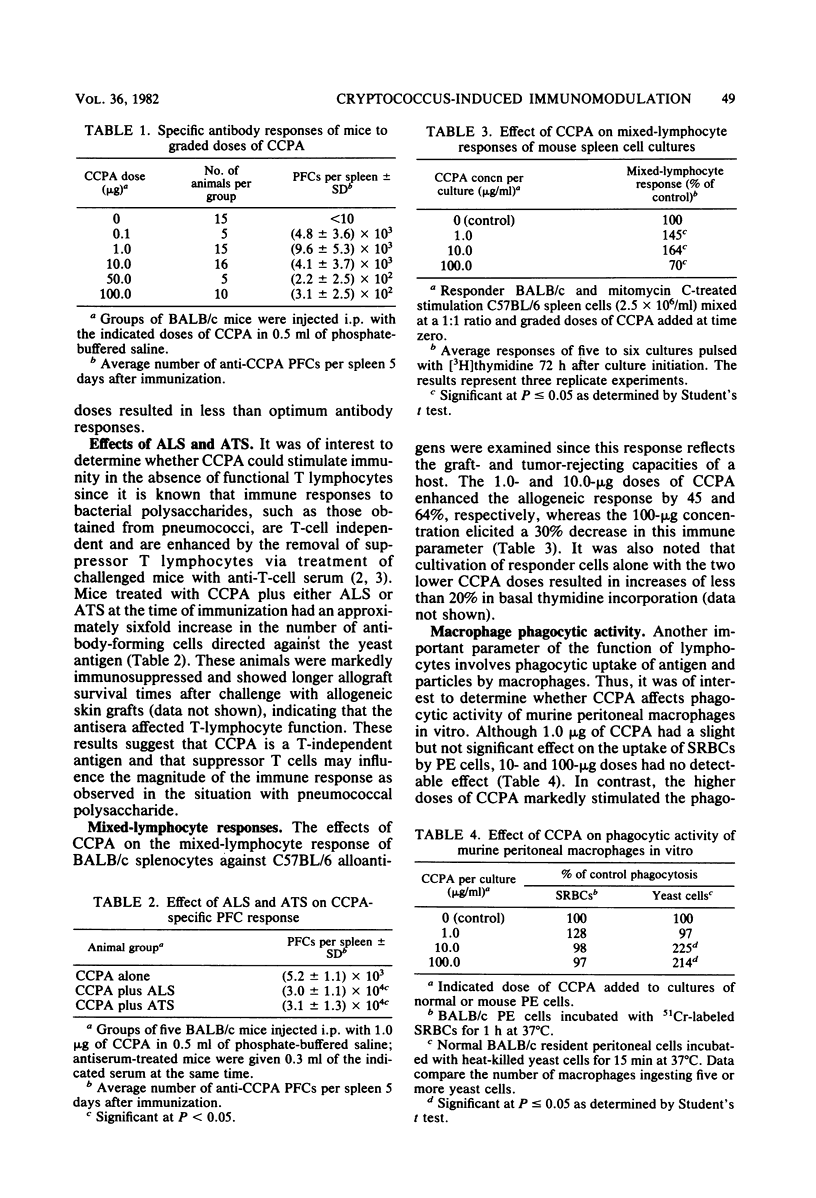
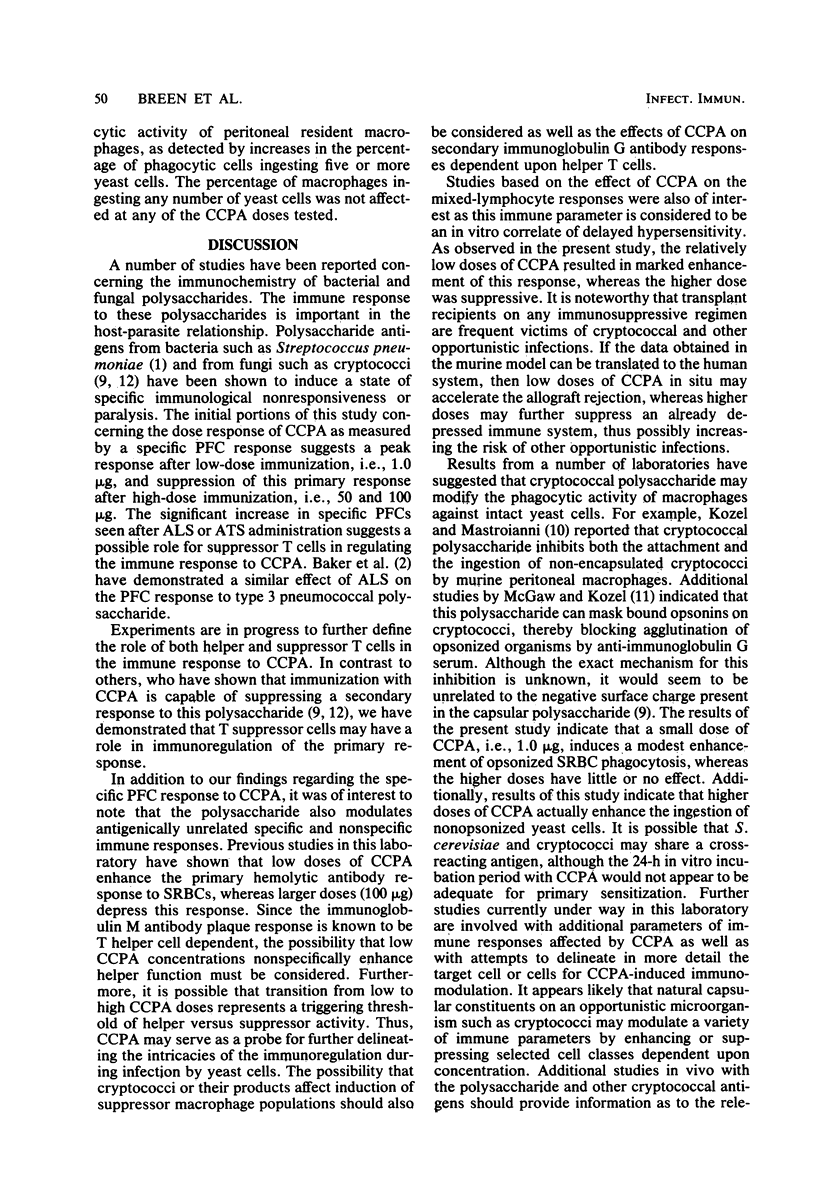
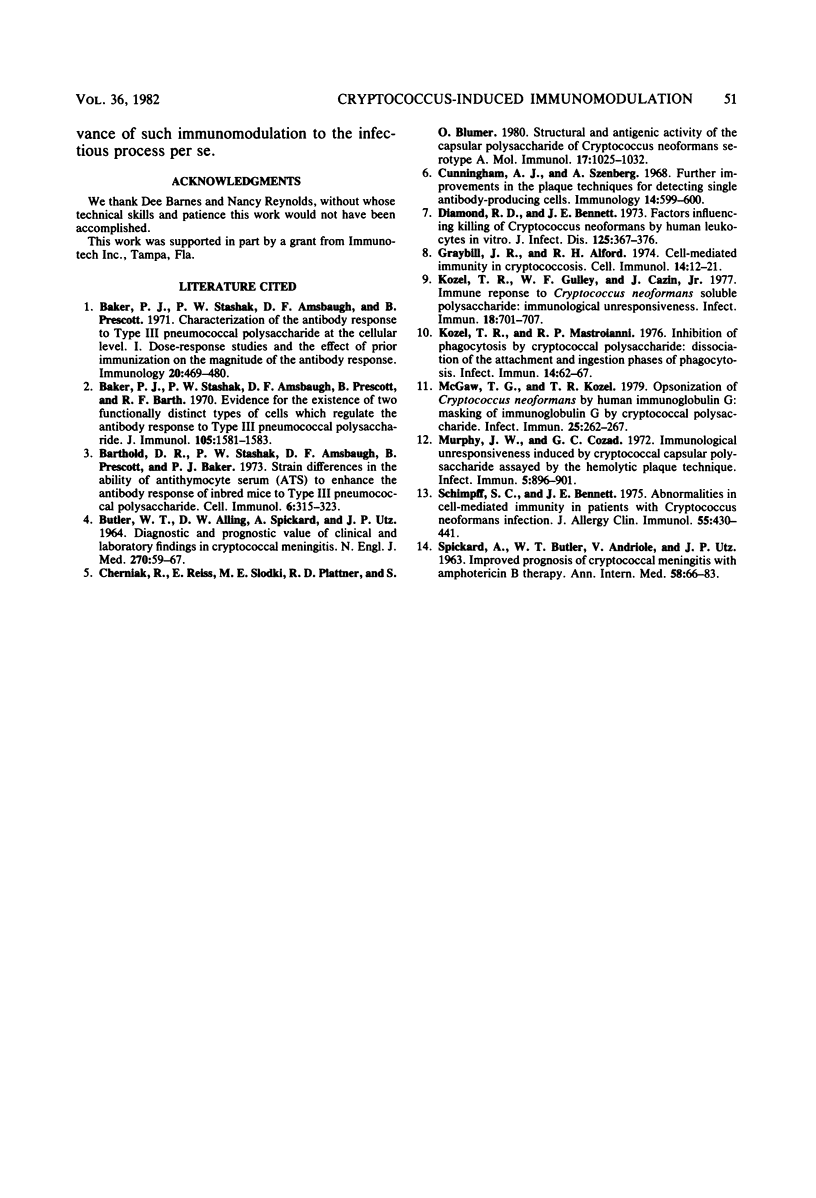
Selected References
These references are in PubMed. This may not be the complete list of references from this article.
- BUTLER W. T., ALLING D. W., SPICKARD A., UTZ J. P. DIAGNOSTIC AND PROGNOSTIC VALUE OF CLINICAL AND LABORATORY FINDINGS IN CRYPTOCOCCAL MENINGITIS, A FOLLOW-UP STUDY OF FORTY PATIENTS. N Engl J Med. 1964 Jan 9;270:59–67. doi: 10.1056/NEJM196401092700201. [DOI] [PubMed] [Google Scholar]
- Baker P. J., Stashak P. W., Amsbaugh D. F., Prescott B., Barth R. F. Evidence for the existence of two functionally distinct types of cells which regulate the antibody response to type 3 pneumococcal polysaccharide. J Immunol. 1970 Dec;105(6):1581–1583. [PubMed] [Google Scholar]
- Baker P. J., Stashak P. W., Amsbaugh D. F., Prescott B. Characterization of the antibody response to type 3 pneumococcal polysaccharide at the cellular level. I. Dose-response studies and the effect of prior immunization on the magnitude of the antibody response. Immunology. 1971 Apr;20(4):469–480. [PMC free article] [PubMed] [Google Scholar]
- Barthold D. R., Stashak P. W., Amsbaugh D. F., Prescott B., Baker P. J. Strain differences in the ability of antithymocyte serum (ATS) to enhance the antibody response of inbred mice to type 3 pneumococcal polysaccharide. Cell Immunol. 1973 Feb;6(2):315–323. doi: 10.1016/0008-8749(73)90031-2. [DOI] [PubMed] [Google Scholar]
- Cherniak R., Reiss E., Slodki M. E., Plattner R. D., Blumer S. O. Structure and antigenic activity of the capsular polysaccharide of Cryptococcus neoformans serotype A. Mol Immunol. 1980 Aug;17(8):1025–1032. doi: 10.1016/0161-5890(80)90096-6. [DOI] [PubMed] [Google Scholar]
- Cunningham A. J., Szenberg A. Further improvements in the plaque technique for detecting single antibody-forming cells. Immunology. 1968 Apr;14(4):599–600. [PMC free article] [PubMed] [Google Scholar]
- Diamond R. D., Root R. K., Bennett J. E. Factors influencing killing of Cryptococcus neoformans by human leukocytes in vitro. J Infect Dis. 1972 Apr;125(4):367–376. doi: 10.1093/infdis/125.4.367. [DOI] [PubMed] [Google Scholar]
- Graybill J. R., Alford R. H. Cell-mediated immunity in Cryptococcosis. Cell Immunol. 1974 Oct;14(1):12–21. doi: 10.1016/0008-8749(74)90164-6. [DOI] [PubMed] [Google Scholar]
- Kozel T. R., Gulley W. F., Cazin J., Jr Immune response to Cryptococcus neoformans soluble polysaccharide: immunological unresponsiveness. Infect Immun. 1977 Dec;18(3):701–707. doi: 10.1128/iai.18.3.701-707.1977. [DOI] [PMC free article] [PubMed] [Google Scholar]
- Kozel T. R., Mastroianni R. P. Inhibition of phagocytosis by cryptococcal polysaccharide: dissociation of the attachment and ingestion phases of phagocytosis. Infect Immun. 1976 Jul;14(1):62–67. doi: 10.1128/iai.14.1.62-67.1976. [DOI] [PMC free article] [PubMed] [Google Scholar]
- McGaw T. G., Kozel T. R. Opsonization of Cryptococcus neoformans by human immunoglobulin G: masking of immunoglobulin G by cryptococcal polysaccharide. Infect Immun. 1979 Jul;25(1):262–267. doi: 10.1128/iai.25.1.262-267.1979. [DOI] [PMC free article] [PubMed] [Google Scholar]
- Murphy J. W., Cozad G. C. Immunological unresponsiveness induced by cryptococcal capsular polysaccharide assayed by the hemolytic plaque technique. Infect Immun. 1972 Jun;5(6):896–901. doi: 10.1128/iai.5.6.896-901.1972. [DOI] [PMC free article] [PubMed] [Google Scholar]
- SPICKARD A., BUTLER W. T., ANDRIOLE V., UTZ J. P. The improved prognosis of cryptococcal meningitis with amphotericin B therapy. Ann Intern Med. 1963 Jan;58:66–83. doi: 10.7326/0003-4819-58-1-66. [DOI] [PubMed] [Google Scholar]
- Schimpff S. C., Bennett J. E. Abnormalities in cell-mediated immunity in patients with Cryptococcus neoformans infection. J Allergy Clin Immunol. 1975 Jun;55(6):430–441. doi: 10.1016/0091-6749(75)90082-2. [DOI] [PubMed] [Google Scholar]


